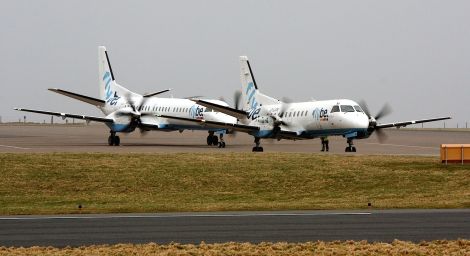News / Lightning strike on plane prompts changes
AIRLINE Loganair has altered some of its autopilot training procedures following a lightning strike on a plane travelling to Shetland which saw the Saab 2000 aircraft plummet at a peak rate of 9,500 feet a minute.
The flight, on 15 December 2014, was travelling from Aberdeen to Sumburgh with 30 passengers and three crew on board.
That caused the aircraft to pitch nose-down to a minimum of 19 degrees, descending 2,900 feet from a height of 4,000 feet before control was regained. The aircraft started to climb again after plummeting to 1,100 feet above sea level.
The original Air Accident Investigation Branch (AAIB) investigation into the incident said recorded data showed that, unbeknownst to the pilot, the autopilot “had remained engaged” when he tried to turn the aircraft upwards.
It is now recommending that the European Aviation Safety Agency (EASA) should review the design of the Saab 2000’s autopilot.
The AAIB said the system should be modified “to ensure that the autopilot does not create a potential hazard when the flight crew applies an override force to the flight controls”.
There had been rain, snow, hail and winds gusting up to 60 knots in the afternoon and early evening.
Visibility dropped from 4,700 metres to 3,300 metres as the Saab 2000 approached Sumburgh. Discontinuing the approach, the pilot turned the aircraft onto a southerly heading.
When lightning struck, the commander informed his co-pilot that he had control of the aircraft, but when attempting to pitch the aircraft upwards his “increasingly aggressive control column inputs did not appear to be having the expected effect”.
The co-pilot, who transmitted a precautionary Mayday call to Air Traffic Control, “similarly perceived that the aircraft was not responding as expected”.
Become a member of Shetland News
The AAIB report stated: “Both pilots considered the possibility that they had lost control of the aircraft, perhaps because of a failure of the fly-by-wire elevator controls following the lightning strike”.
As the aircraft neared its lowest point of 1,100 feet above sea level, the ground proximity warning system generated “sink rate” and “pull up” warnings. The commander applied full power, and the aircraft began climbing.
The climb continued and the aircraft was diverted to Aberdeen, where it enjoyed an “uneventful” landing.
A passenger on the flight in question, Shona Manson, said there had been “an almighty bang and a flash that went over the left wing” of the plane. She said for anyone who was a bad flyer the journey would have been their “worst nightmare”.
One Glaswegian passenger was so shaken by the experience that he went home rather than getting on a flight to Shetland the following day.
A notice was issued to Saab 2000 pilots on 23 December that year advising them to ensure that the autopilot is disconnected “in the event of experiencing control abnormalities”.
All Saab 2000 pilots were also briefed on the incident four days after it took place.
Loganair’s director of flight operations Andy Thornton said the airline welcomed the findings of the AAIB’s latest report and took on board its content.
“Immediately following this incident, Loganair issued enhanced guidance in consultation with the aircraft manufacturer to all company pilots flying the Saab 2000,” he said.
“We also amended our training syllabus and worked with our third-party provider to augment and refine training procedures to include a scenario similar to that experienced by our flight crew in December 2014.”
Thornton added: “Our pilots regularly go through extensive training and Loganair prides itself on the excellent standards and quality of its pilot workforce.”
All pilots new to Saab 2000 aircraft are given eight hours of simulator conversion training including the circumstances of this incident and the corrective action required.
Become a member of Shetland News
Shetland News is asking its many readers to consider paying for membership to get additional features and services: -
- Remove non-local ads;
- Bookmark posts to read later;
- Exclusive curated weekly newsletter;
- Hide membership messages;
- Comments open for discussion.
If you appreciate what we do and feel strongly about impartial local journalism, then please become a member of Shetland News by either making a single payment, or setting up a monthly, quarterly or yearly subscription.






























































